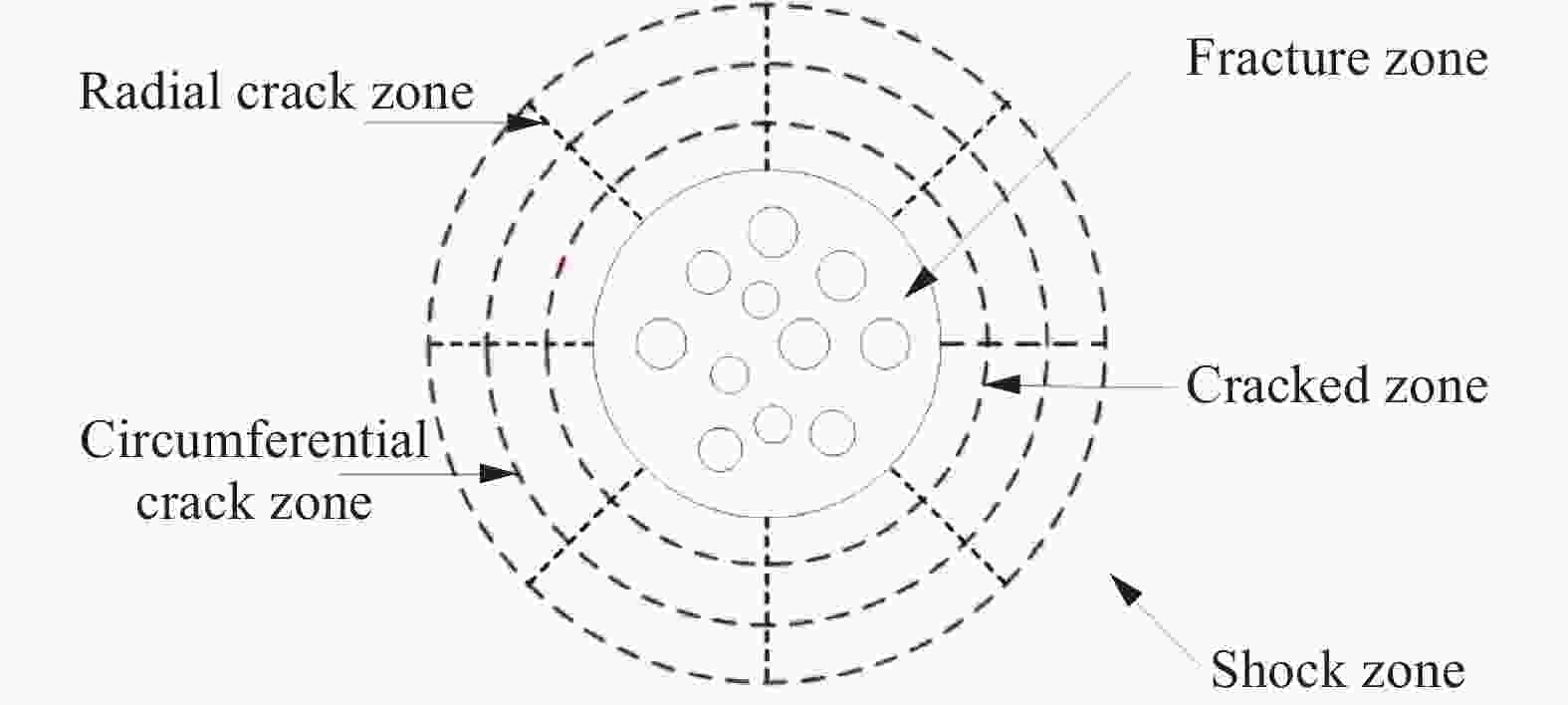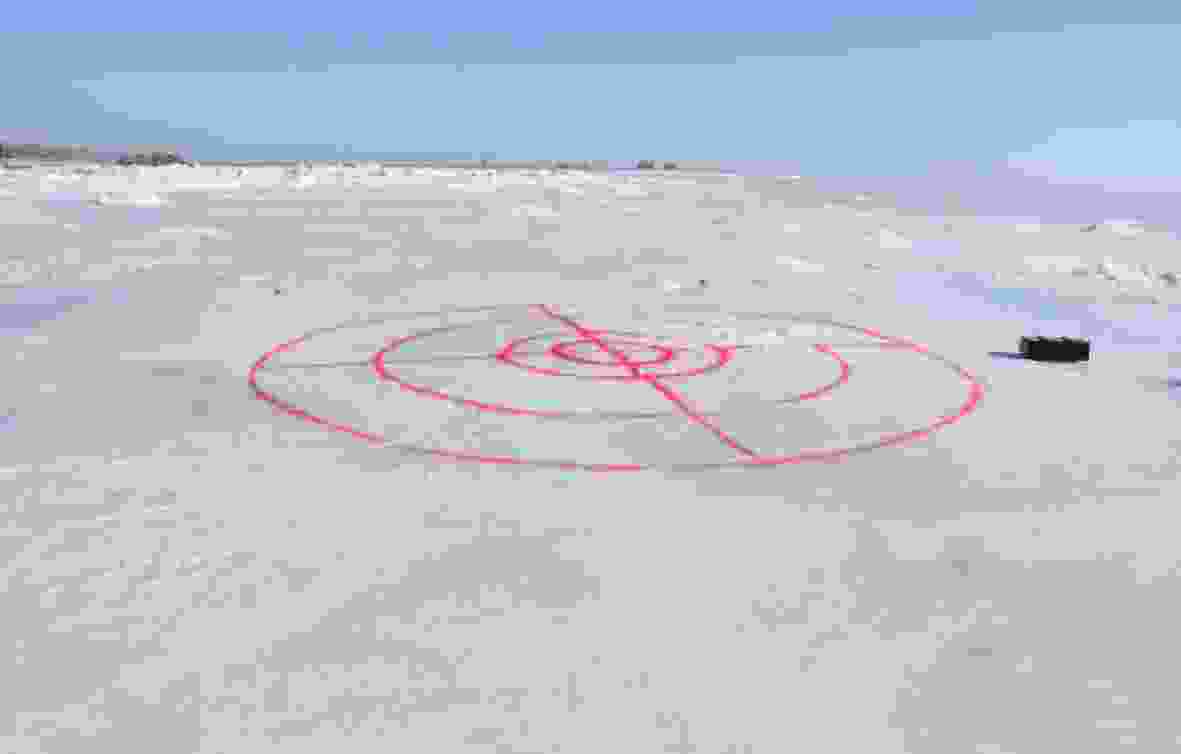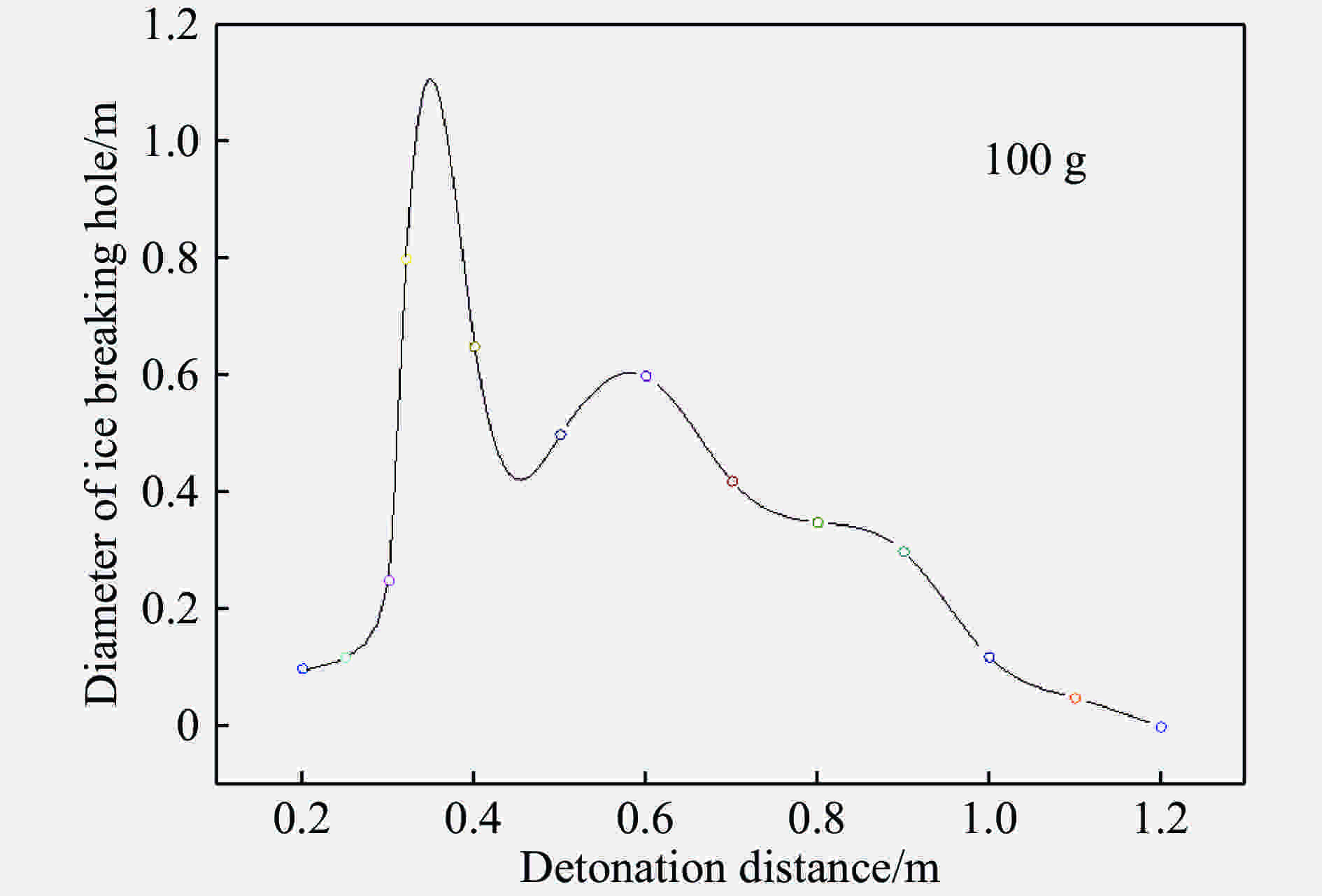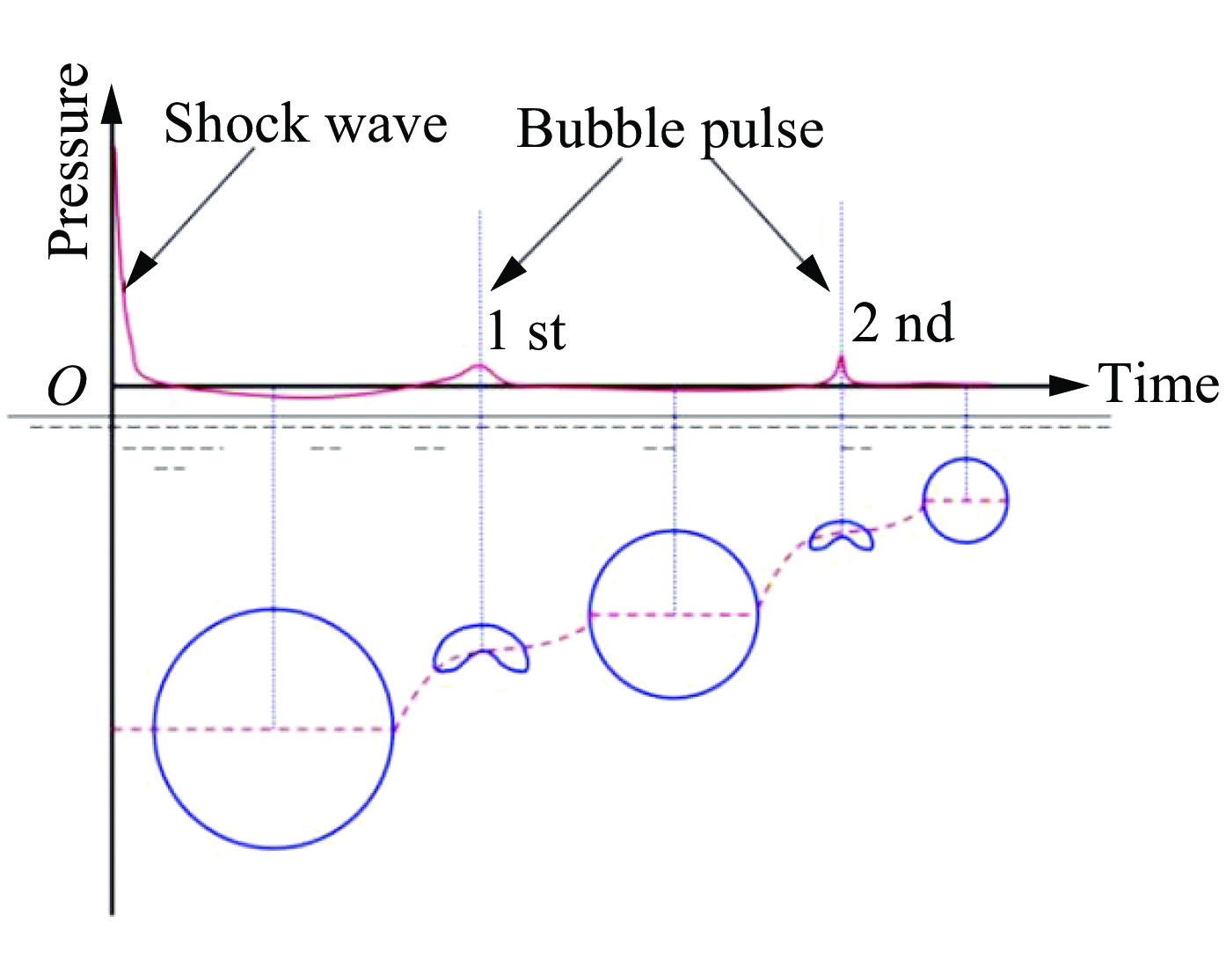Fragmentation of ice cover subjected to underwater explosion shock wave load and its influence factors
-
摘要: 水下爆炸破冰是复杂的爆破工程,为了研究冰层在水下爆炸冲击波载荷作用下的破碎特性及规律,利用几何动力分析软件LS-DYNA对水下爆炸破冰的过程进行数值模拟,并将计算结果与实验结果进行对比,误差在8%以内,验证了数值模型的有效性。根据本文中的建模方法及建立的模型,计算不同的实验工况:实验场地环境不变,调整爆距分析不同爆距下冰层破碎特性;调整药量、爆距和冰厚,通过正交设计方法设计9组实验方案,应用灰色系统理论对3种因素进行分析,建立了各个因素与破冰半径之间的灰色关联度系数及灰色关联度。分析结果表明:药量为100 g,冰厚为29 cm,水深为2.9 m,爆距范围为0.3~1.5 m破冰的半径范围为0~1.1 m,最佳爆距范围在0.3~0.45 m之间;根据以上9种工况的分析可知,药量(100、200、300 g)、爆距(0.3、0.6、0.9 m)和冰厚(24、28、32 cm)对破冰半径的影响的主次关系依次为爆距、药量、冰厚。Abstract: Ice breaking by blasting is a complex process in underwater explosion engineering. In this study we examined the fragmentation characteristics of ice cover with underwater explosion shock wave and simulated the process of underwater explosion breaking ice process using LS-DYNA. We also compared the simulation result with the experimental data and found the min good agreement. Based on this we verified the simulation model and calculated different conditions. Then, keeping the test environment unchanged, we set different detonation distances, and calculated the radius of the ice breaking hole; varying the charge dosage, the detonation distance and the ice thickness, we designed nine group simulation conditions by the orthogonal design method, and analyzed the gray relational degrees and gray incidence coefficients between radius of breaking ice hole and different factors at different levels using the gray system theory. The analytical results showed that, at 100 g of the dosage, the ice thickness is 29 cm, the water depth is 2.9 m, the detonation distance range is 0.3−1.5 m, the radius range of breaking ice hole is 0−1.1 m, and the best detonation distance is between 0.3−0.45 m. According to the analysis of the above nine simulation conditions, the influencing factors that matter most remarkably in underwater ice breaking are the detonation distance (0.3, 0.6, 0.9 m), the dosage (100, 200, 300 g), and the ice thickness (24, 28, 32 cm), in order of their importance.
-
表 1 数值模拟中的材料模型和状态方程
Table 1. Material models and equation of statefor numerical simulation
材料 本构模型 状态方程 炸药 MAT_HIGH_EXPLOSIVE_BURN JWL 水 MAT_NULL Grüneisen 冰 MAT_ISOTROPIC_ELASTIC_FAILURE 无 土壤 MAT_ NULL LINER_POLYNOMAL 空气 MAT_ NULL LINER_POLYNOMAL 表 2 正交试验因素水平
Table 2. Factor level of orthogonal experiment
水平 X1/g X2/m X3/m 1 100 0.3 0.24 2 200 0.6 0.28 3 300 0.9 0.32 表 3 正交试验设计方案
Table 3. Factor level of orthogonal experiment
工况 X1/g X2/m X3/m 1 100 0.3 0.24 2 100 0.6 0.28 3 100 0.9 0.32 4 200 0.3 0.32 5 200 0.6 0.24 6 200 0.9 0.28 7 300 0.3 0.28 8 300 0.6 0.32 9 300 0.9 0.24 表 4 正交试验各序列区域值
Table 4. Sequences region value of orthogonal experiment
工况 x1 x2 x3 y 1 0 0 0 0.112 2 0 0.5 0.5 0.557 3 0 1.0 1.0 0.447 4 0.5 0 1.0 0.223 5 0.5 0.5 0 1.000 6 0.5 1.0 0.5 0.223 7 1.0 0 0.5 0.111 8 1.0 0.5 1.0 0 9 1.0 1.0 0 0.668 表 5 不同因素在不同水平下对破冰半径的关联度系数及关联度
Table 5. Gray relational degrees and gray incidence coefficients between radius ofbreaking ice breaking hole and different factors at different levels
工况 关联度系数 药量X1 爆距X2 冰厚X3 1 0.940 0.970 0.940 2 0.632 1.000 1.000 3 0.687 0.633 0.633 4 0.796 0.834 0.543 5 0.659 0.659 0.476 6 0.796 0.543 0.796 7 0.507 0.94 0.721 8 0.476 0.659 0.476 9 0.757 0.757 0.584 关联度 0.694 0.774 0.685 -
[1] 夏长富. 水下人工爆破冰凌技术研究与实践 [J]. 爆破, 2014, 31(2): 126–129. DOI: 10.3963/j.issn.1001-487X.2014.02.028.XIA Changfu. Research and practice of underwater ice jam breaking by manual-operated blasting [J]. Blasting, 2014, 31(2): 126–129. DOI: 10.3963/j.issn.1001-487X.2014.02.028. [2] 张雨, 李岳阳, 王敏. 极地破冰船发展现状与趋势 [J]. 舰船科学与技术, 2017, 39(12): 188–193. DOI: 10.3404/j.issn1672-7649. 2017.12.040.ZHANG Yu, LI Yueyang, WANG Min. Overview and trend of the icebreakers [J]. Ship and Technology, 2017, 39(12): 188–193. DOI: 10.3404/j.issn1672-7649. 2017.12.040. [3] 解文辉, 何秉顺, 李华新. 黄河防凌爆炸破冰效果 [J]. 工程爆破, 2014, 20(6): 29–31. DOI: 10.3969/j.issn.1006-7051.2014.06.007.XIE Wenhui, HE Bingshun, LI Huaxin. The effect of ice breaking by explosion for the yellow river ice flood prevention [J]. Engineering Blasting, 2014, 20(6): 29–31. DOI: 10.3969/j.issn.1006-7051.2014.06.007. [4] 曲艳东, 刘万里, 翟诚. 水下爆炸冲击波传播规律数值分析 [J]. 爆破, 2017, 34(2): 100–104. DOI: 10.3963/j.issn.1001-487X.2017.02.019.QU Yandong, LIU Wanli, ZHAI Cheng. Numerical simulation of propagation law of shock waves in process of breaking ice by underwater blasting [J]. Blasting, 2017, 34(2): 100–104. DOI: 10.3963/j.issn.1001-487X.2017.02.019. [5] 张忠和, 梁向前, 王树理. 水下爆破破冰机理的数值分析研究 [J]. 爆破, 2015, 32(6): 150–155. DOI: 10.3963/j.issn.1001-487X.2015.03.027.ZHANG Zhonghe, LIANG Xiangqian, WANG Shuli. Numerical simulation of ice breaking mechanism of underwater blasting [J]. Blasting, 2015, 32(6): 150–155. DOI: 10.3963/j.issn.1001-487X.2015.03.027. [6] 吴瑞波, 郝明盛, 武彩岗, 等. 水中爆破破冰参数的优化实验 [J]. 工程爆破, 2014, 20(6): 25–28. DOI: 10.3969/j.issn.1006-7051.2014.06.006.WU Ruibo, HAO Mingsheng, WU Caigang, et al. The parameters optimization experiment of ice breaking by underwater blasting [J]. Engineering blasting, 2014, 20(6): 25–28. DOI: 10.3969/j.issn.1006-7051.2014.06.006. [7] 钟冬望, 黄小武, 殷秀红, 等. 水下爆炸冲击波的数值模拟与实验研究 [J]. 爆破, 2015, 32(4): 14–18. DOI: 10.3963/j.issn.1001-487X.2015.04.004.ZHONG Dongwang, HUANG Xiaowu, YIN Xiuhong, et al. Numerical simulation and experimental study of underwater explosion shock wave [J]. Blasting, 2015, 32(4): 14–18. DOI: 10.3963/j.issn.1001-487X.2015.04.004. [8] 姚熊亮, 汪玉, 张阿漫. 水下爆炸气泡动力学[M]. 哈尔滨: 哈尔滨工程大学出版社, 2012: 1−3. [9] 宗智, 赵延杰, 邹丽. 水下爆炸结构毁伤的数值计算[M]. 北京:科学出版社, 2014: 3−7. [10] 郭军伟. 冰体力学性质及其受到爆炸与冲击波作用研究[D]. 郑州: 华北水利水电大学, 2014: 34−37. [11] 康德, 严平. 基于LS-DYNA的高速破片水中运动特性流固耦合数值模拟 [J]. 爆炸与冲击, 2014, 34(5): 534–538. DOI: 10.11883/1001-1455(2014)05-0534-05.KANG De, YAN Ping. Movement characteristics of high-velocity fragments in water medium: numerical simulation using LS-DYNA [J]. Explosion and Shock Waves, 2014, 34(5): 534–538. DOI: 10.11883/1001-1455(2014)05-0534-05. [12] 顾强, 张世豪, 安晓红, 等. 基于灰色理论的两点爆炸起爆参数优化设计 [J]. 爆炸与冲击, 2015, 35(3): 359–365. DOI: 10.11883/1001-1455(2015)03-0359-07.GU Qiang, ZHANG Shihao, AN Xiaohong, et al. Optimization design for priming parameters of two-point explosion based on gray theory [J]. Explosion and Shock Waves, 2015, 35(3): 359–365. DOI: 10.11883/1001-1455(2015)03-0359-07. [13] 林加剑, 任辉启, 沈兆武. 应用灰色系统理论研究爆炸成形弹丸速度的影响因素 [J]. 弹箭与制导学报, 2009, 29(3): 112–116. DOI: 10.3969/j.issn.1673-9728.2009.03.033.LIN Jiajian, REN Huiqi, SHEN Zhaowu. Study on primary influence factors for application of gray system theory to velocity of explosive forming projectile [J]. Journal of Projectiles Rockets Missiles and Guidance, 2009, 29(3): 112–116. DOI: 10.3969/j.issn.1673-9728.2009.03.033. [14] 傅立. 灰色系统理论及其应用[M]. 北京: 科学技术文献出版社, 1992: 1−20. [15] 吕锋. 灰色系统关联度之分辨率系数的研究 [J]. 系统工程理论与实践, 1997, 17(6): 49–54. DOI: 10.3321/j.issn:1000-6788.1997.06.011.LYU Feng. Research on the identification coefficient of relational grade for grey system [J]. Systems Engineering Theory and Practice, 1997, 17(6): 49–54. DOI: 10.3321/j.issn:1000-6788.1997.06.011. -






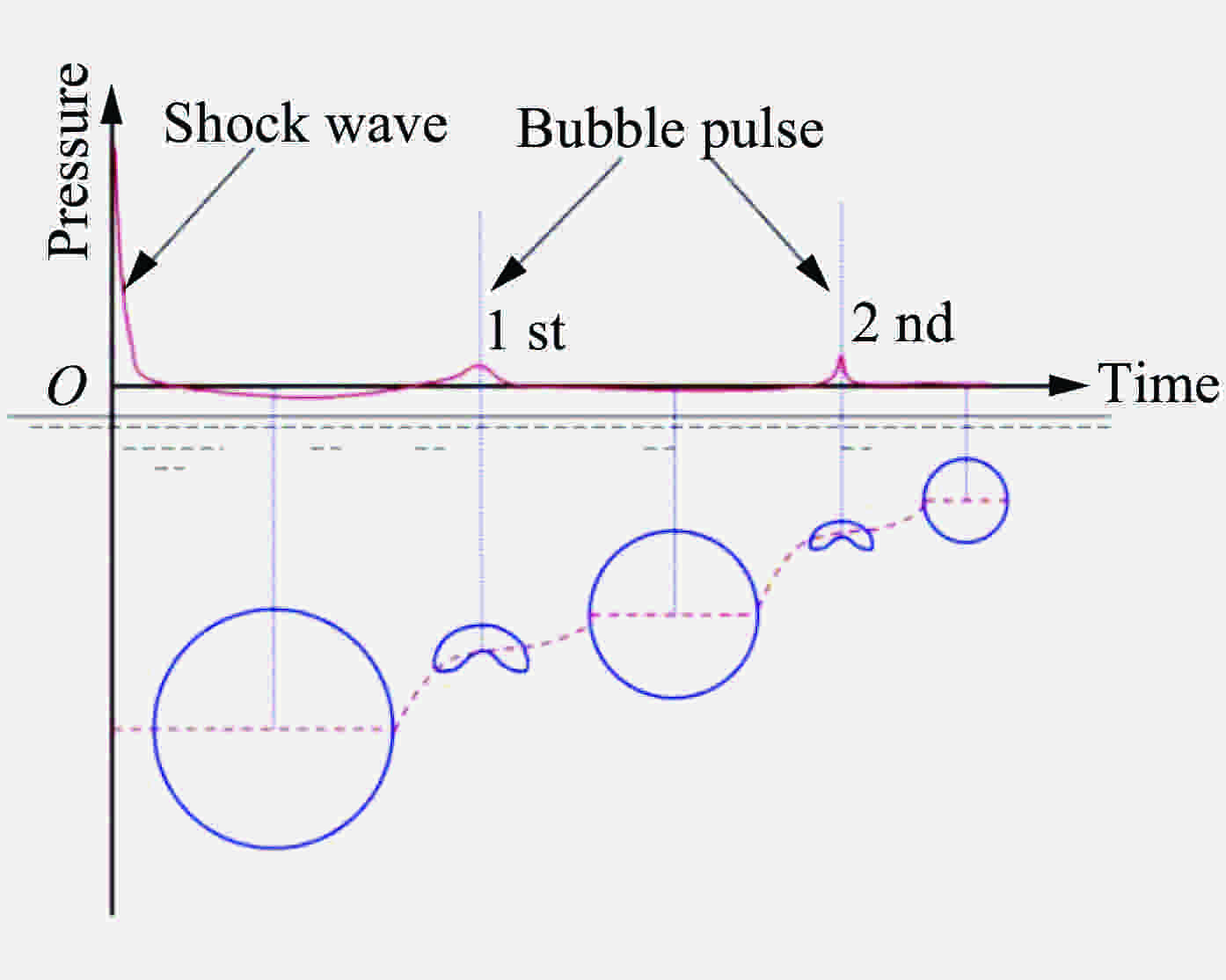
 下载:
下载:

